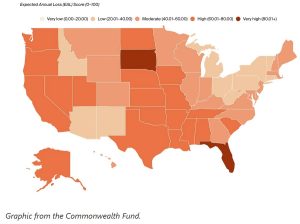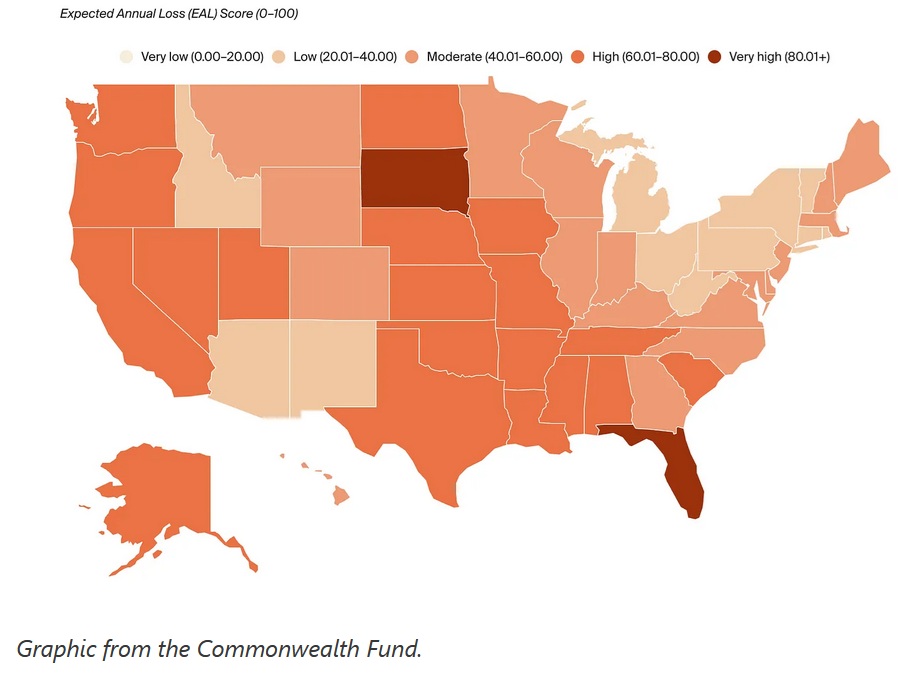
UNDATED – South Dakota’s healthcare infrastructure faces significant vulnerability to extreme weather and natural hazards, according to a groundbreaking Commonwealth Fund study that ranks the state among those at highest risk due to severe winter weather and extreme storms.
The Commonwealth Fund State Scorecard on Climate, Health, and Health Care, released September 25, represents the first state-by-state assessment of how climate change threatens both public health and healthcare delivery systems across the nation.
While the study does not provide South Dakota’s overall ranking, it specifically identifies the state alongside Florida as facing especially notable risks to healthcare infrastructure from natural hazards. Unlike coastal Florida, which confronts flooding and hurricanes, South Dakota’s vulnerabilities stem from harsh continental weather patterns.
The analysis examined all 50 states on eight indicators, including air quality, extreme heat risk, natural hazard vulnerability, flood risk to healthcare facilities, energy efficiency policies, electricity generation emissions, healthcare sector emissions, and healthcare worker commuting emissions.
Northern Plains States Face Mixed Results
Across the Northern Plains region—which includes Montana, Wyoming, Nebraska, North Dakota, and South Dakota—states showed varied performance on climate and health preparedness.
West Virginia, Wyoming, and North Dakota registered the highest per capita greenhouse gas emissions from healthcare, correlating with their emissions-intensive electricity production. The high emissions reflect these states’ continued heavy reliance on fossil fuels for power generation.
North Dakota remains one of the top coal- and oil-producing states in the country, with net emissions increasing 33 percent from 1990 to 2022. However, the state has made progress in renewable energy, with roughly half of in-state electricity generation now sourced from renewables and wind power more than doubling from 2015 to 2023.
The healthcare sector nationwide contributes significantly to climate challenges. In the United States, the healthcare sector accounts for 8.5 percent of the nation’s total greenhouse gas emissions, stemming primarily from production and transportation of medical goods and services.
Top and Bottom Performers
Nationally, Vermont, New York, Washington, New Jersey, and Maine achieved the top rankings overall, benefiting from lower environmental risk and vulnerability as well as stronger decarbonization and clean energy policies.
West Virginia, Kentucky, Louisiana, Florida, and Mississippi ranked among the lowest-performing states. These states face more frequent and intense environmental hazards while lacking supportive energy and environmental policies.
Southwestern states face the greatest health risks from extreme heat, while low-lying coastal states like Florida and Louisiana have more healthcare infrastructure at risk of flooding. The study emphasizes that both coastal and inland states face high risk from natural hazards.
Climate Change Intensifying Risks
The Northern Great Plains region is experiencing unprecedented climate-driven extremes. The region faces severe drought, floods, and wildfires that threaten economic sectors such as agriculture and recreation while affecting residents’ health, well-being, and livelihoods.
For healthcare facilities specifically, extreme weather poses multiple threats: disrupting supply chains, creating transportation challenges for patients and staff, overburdening emergency rooms, and causing significant financial losses that can ultimately lead to worse patient outcomes.
The study comes as climate-related disasters continue mounting. Last year alone, the National Oceanic and Atmospheric Administration reported 27 weather and climate disasters with damage topping $1 billion each, resulting in 568 direct or indirect deaths, making 2024 the eighth-highest fatality year in the last 45 years.
Recommendations for Action
The Commonwealth Fund researchers recommend South Dakota and other states prioritize several key actions: strengthening clean energy and energy efficiency policies, supporting healthcare facilities in preparing for extreme weather and assessing climate risks, requiring standardized reporting of healthcare sector emissions, and helping hospitals invest in climate-resilient infrastructure and clean power.
“People are better off when they can breathe clean air and when the hospitals they depend on are prepared for extreme weather,” Commonwealth Fund President Joseph Betancourt said in a statement.
The study analyzed publicly available federal and state data from 2020 to 2024, examining factors that can be addressed through policy changes at local, state, or federal levels and proactive measures by healthcare systems.


